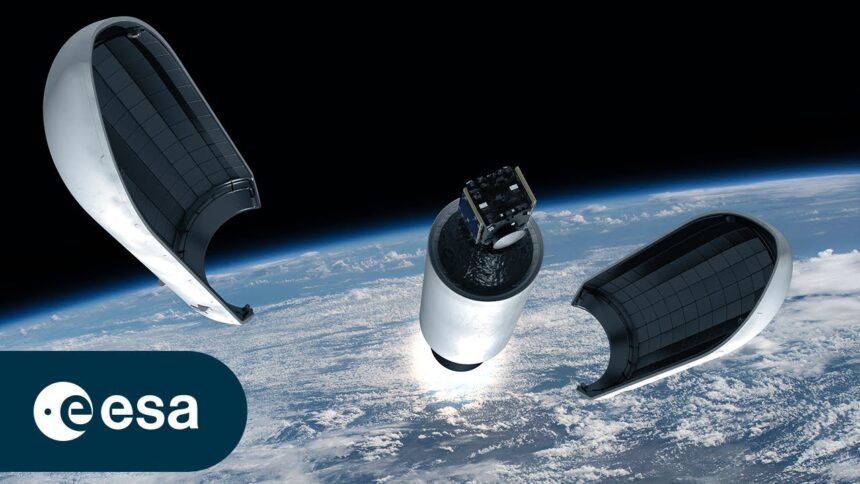SpaceX has launched the European Space Agency’s (ESA) Hera mission, sending it on a journey to investigate the aftermath of NASA’s earlier asteroid impact experiment with DART (Double Asteroid Redirection Test). Hera, launched from Cape Canaveral just before the impending Hurricane Milton, will arrive at its destination in late 2026. This mission represents an important collaborative effort between ESA and NASA, combining resources and expertise to explore effective planetary defense strategies.
What’s Happening & Why This Matters
Two years ago, NASA’s DART spacecraft collided with an asteroid, Dimorphos, in the first test of asteroid deflection technology. This experiment successfully altered the asteroid’s orbit, demonstrating that a kinetic impactor could potentially deflect a celestial object heading toward Earth. However, the DART impact left no immediate opportunity to closely study the post-collision effects on Dimorphos, as the spacecraft was sacrificed in the experiment.
ESA’s Hera mission now aims to fill in the gaps left by DART. This follow-up mission, launched by SpaceX’s Falcon 9 rocket, will comprehensively examine Dimorphos, providing detailed images and data that will reveal the full extent of the impact’s effects. Hera’s primary goal is to gather data that could help scientists understand the feasibility of asteroid deflection as a defense mechanism for Earth.
The Launch Details
On October 9, 2024, SpaceX launched the 2,442-pound Hera spacecraft aboard its Falcon 9 rocket. With Hurricane Milton approaching, conditions were tense, but SpaceX proceeded with a smooth liftoff. This Falcon 9 mission marks a pivotal moment, with the booster forgoing recovery to give Hera the speed it needed to break free from Earth’s gravitational pull. Falcon 9’s upper stage successfully propelled Hera to a record-breaking speed of 26,745 mph, enabling it to escape Earth’s orbit.
Hera will utilize a flyby of Mars in 2025 to slingshot toward its final destination, where it will perform a close survey of the Didymos-Dimorphos binary asteroid system. Scientists are especially interested in observing changes in Dimorphos’ physical structure and orbit, using Hera’s instruments to document any structural alterations caused by DART’s impact.
The Mission’s Purpose and Importance
Hera’s arrival will provide crucial information on the DART impact’s aftermath. Unlike DART, which provided limited imagery through its Italian CubeSat, Hera will conduct an in-depth survey of the impact site, recording details of Dimorphos’ composition and any newly created craters. Additionally, the mission will measure Dimorphos’ mass, a critical factor for calculating the deflection effectiveness of such impact missions.
Patrick Michel, the mission’s principal investigator, likens Hera’s role to that of a detective, piecing together data to validate or adjust planetary defense models. “We need to know the final outcome,” Michel stated, emphasizing the importance of understanding the asteroid’s altered state.

Hera will also deploy two CubeSats, Juventas and Milani, for close-up analysis. These mini-satellites will examine Dimorphos’ surface minerals and internal structure, and Juventas is set to attempt a landing, a move that could provide unparalleled insights into the asteroid’s makeup. ESA’s Director-General, Josef Aschbacher, calls Hera “ESA’s contribution to humanity’s future safety.”
Technical and Logistical Challenges
As Hera journeys to Didymos and Dimorphos, it will navigate through potentially hazardous debris from the DART impact, which scattered boulders in the asteroid system. ESA’s team has prepared for this, balancing the risks with the scientific need to understand the outcomes of a planetary defense mission. This part of the mission will help refine future protocols for similar missions, as engineers and scientists learn how best to operate in debris-filled environments.
Moreover, Hera’s planned close approach to the Didymos-Dimorphos system at a mere half-mile distance will provide granular data previously unavailable. The mission team will monitor the region for boulders, leveraging experience from past missions to assess risks. This cautious approach, explained by ESA flight director Ignacio Tanco, highlights the ongoing balance between exploration and safety in asteroid missions.
TF Summary: What’s Next
Hera’s mission will yield essential data to help ESA and NASA refine planetary defense strategies, a critical step toward developing systems to protect Earth from potential asteroid threats. With its suite of scientific instruments and CubeSats, Hera will deliver a comprehensive view of Dimorphos and Didymos, offering insights into asteroid composition and response to kinetic impact. This mission may define a foundational understanding for future asteroid deflection missions. As humanity’s first step toward coordinated planetary defense, the Hera mission marks a collaborative effort to make Earth safer against cosmic hazards.
— Text-to-Speech (TTS) provided by gspeech


